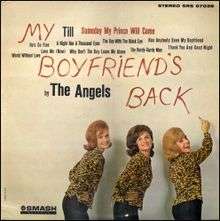My Boyfriend's Back (album)
My Boyfriend's Back is the second studio album released by the American pop girl group The Angels. It was issued on the Smash Records label in September 1963. The album was produced by Robert Feldman, Jerry Goldstein, and Richard Gottehrer. It features the Angels' biggest hit, "My Boyfriend's Back", which reached number one on the Billboard Hot 100.[1] Composed by the team of Bob Feldman, Jerry Goldstein, and Richard Gottehrer, "My Boyfriend's Back" sold over one million copies, and was awarded a gold disc.[2]
| My Boyfriend's Back | ||||
|---|---|---|---|---|
 | ||||
| Studio album by | ||||
| Released | September 1963 | |||
| Recorded | 1963 | |||
| Genre | Pop | |||
| Label | Smash | |||
| Producer | Robert Feldman, Jerry Goldstein, Richard Gottehrer | |||
| The Angels chronology | ||||
| ||||
| Singles from My Boyfriend's Back | ||||
| ||||
Peggy Santiglia was by this time the lead singer of the Angels but included on the album is the group's first hit "Till" which was originally recorded in 1961 with the group's previous lead singer, Linda Jansen. It is unspecified if the track was re-recorded with Santiglia on lead or not. There is also a cover version of The Chiffons' "He's So Fine" as The Chiffons had covered "My Boyfriend's Back," and a reading of "Someday My Prince Will Come" from the 1937 film Snow White and the Seven Dwarfs. The album sold fairly well and charted at number 33 on the US Billboard 200 Albums chart, the group's most successful effort.[3]
Track listing
Side 1
- "My Boyfriend's Back"
- "Someday My Prince Will Come"
- "Has Anybody Seen My Boyfriend"
- "'Til"
- "The Night Has a Thousand Eyes"
- "Why Don't the Boy Leave Me Alone"
Side 2
- "He's So Fine"
- "Thank You and Goodnight"
- "The Hurdy-Gurdy Man"
- "World Without Love"
- "(Love Me) Now"
- "The Guy with the Black Eye"
Personnel
- Peggy Santiglia - lead vocals
- Barbara Allbut - vocals
- Phyllis Allbut - vocals
Singles history
- "My Boyfriend's Back" b/w "(Love Me) Now" (U.S. #1)[4]
- "Thank You and Goodnight" (U.S. #84)[5]
References
- Bronson, Fred (2003).The Billboard Book of Number One Hits: The Inside Story Behind Every Number One Single on Billboard's Hot 100 from 1955 to the Present (5 ed.). Billboard Books. p. 136. ISBN 0-8230-7677-6.
- Murrells, Joseph (1978).The Book of Golden Discs (2nd ed.). London: Barrie and Jenkins Ltd. p.153.ISBN 0-214-20512-6.
- Whitburn, Joel (1996).Top Pop Albums 1955-1996 (4 ed.). Hal Leonard Publishing Corporation. p.36. ISBN 0-89820-117-9
- Bronson, Fred (2003).The Billboard Book of Number One Hits: The Inside Story Behind Every Number One Single on Billboard's Hot 100 from 1955 to the Present (5 ed.). Billboard Books. p. 136. ISBN 0-8230-7677-6.
- Whitburn, Joel (2009).Top Pop Singles 1955-2008 (12th ed.). Menomonee Falls, Wisconsin: Record Research Inc. p.42